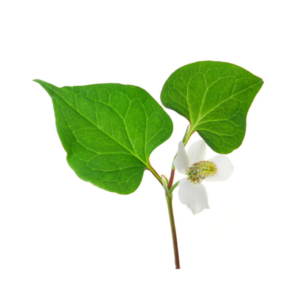Houttuynia Cordata is also known as Heartleaf, Fish Mint, Fish Leaf, Fish Wort, Chameleon Plant, Chinese Lizard Tail, Bishop’s Weed, or Rainbow Plan. It’s from the family of Saururaceae. The pungent roots of the herb are eaten as a vegetable in some Asian dishes, and used as a medicinal preparation, especvially for skincare products.
The medicinal plant sourced ingredient is popular in Asia. Apart from its consumption as a delicacy, it has a rich history of medicinal use and numerous studies have reported its pharmacological activity against inflammation, cancer, viruses, bacteria, hyperglycaemia, obesity, etc. The various phytoconstituents that have been isolated from this plant include flavonoids, phenolic acids, volatile/essential oils and alkaloid.
 Bioactive compounds called flavonoids—a family of polyphenolic compounds in plants can be isolated from Houttuynia cordata, like: Quercetin, Quercitrin, Hyperoside, Rutin, Afzelin, and Apigenin. These are “polyphenolic flavonoids”, antioxidants that can scavenge oxygen free radicals and offer anti-inflammatory effects.
Bioactive compounds called flavonoids—a family of polyphenolic compounds in plants can be isolated from Houttuynia cordata, like: Quercetin, Quercitrin, Hyperoside, Rutin, Afzelin, and Apigenin. These are “polyphenolic flavonoids”, antioxidants that can scavenge oxygen free radicals and offer anti-inflammatory effects.
Houttuynia Cordata also contains polysaccharides—large molecule sugars, including galacturonic acid, galactose, arabinose, and glucuronic acid. In skincare polysaccharides are humectants, attracting water to and holding it within the skin. They moisturize the skin and help it maintain and elasticity and softness. These polysacharides also exhibit antioxidant effects and can scavenge free radicals.
The skin on your face is typically the most UV exposed area on your body. Exposure to UVB radiation causes oxidative damage to the skin, resulting in premature aging, sunburn, inflammation, hyper-pigmentation, dehydration, and even skin cancer. UV stimulates production of reactive oxygen species (ROS) that can damage skin cells. The Quercitrin found in Houttuynia Cordata may have a protective effect against ROS generated through UVB exposure. The antioxidants also help in reducing the appearance of wrinkles and fine lines.
Acne-prone skin receives particular benefit from the antibacterial properties. Houttuynia Cordata extract has an antimicrobial effect on the P. Acne bacteria and Staphylococcus epidermidis most commonly associated with acne breakouts. Acne-causing bacteria stimulate pro-inflammatory cytokines that results in the presentation of lesionsa, (pimples). A study, Houttuynia Cordata to effectively reduce the upregulation of pro-inflammatory cytokines. Another study from 2019 concluded that application of Houttuynia Cordata for about 2 months can help with mild to moderate inflammatory acne.
Houttuynia Cordata has also been studied for the treatment of atopic dermatitis, or eczema. Staphylococcus Aureus is thought.to be one of the bacteria inducing eczema, and Houttuynia Cordata inhibits upregulation of pro-inflammatory cytokines. offering saome relief for eczema.
And when it somes to smoothing melanin production, and improving sun-damage and hyperpigmentation, free radicals and the high phenolic content in Houttuynia Cordata reduces tyrosinase activity and may inhibit melanin synthesis. So it’s knows to help lighten and brighte the complexion!

